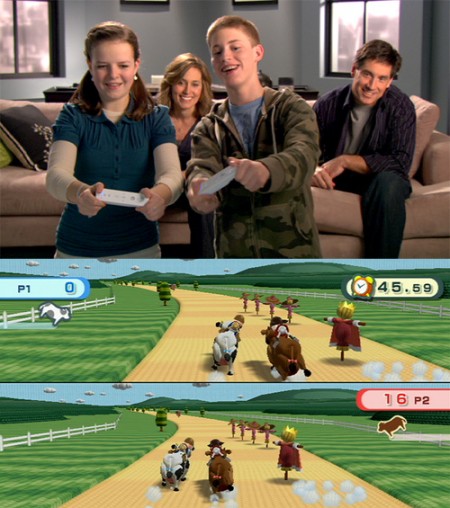Truth is stranger than fiction theory: Ikea is selling a new bench called Jesper, apparently dedicated to video game playing. I am not so convinced about the ergonomics, but here you go:

(Thanks to Ian Bogost for spotting this!)
My name is Jesper Juul, and I am a Ludologist [researcher of the design, meaning, culture, and politics of games]. This is my blog on game research and other important things.
Truth is stranger than fiction theory: Ikea is selling a new bench called Jesper, apparently dedicated to video game playing. I am not so convinced about the ergonomics, but here you go:

(Thanks to Ian Bogost for spotting this!)
Enthusiast site Ars Technica declares that “Wii Play becomes first bad game to sell 10 million“.
While Wii Play isn’t my favorite game, perhaps the Ars Technica headline and the 61% GameRanking average are both misleading? I do think it contains a good deal of enjoyable minigames suitable for a lazy afternoon.
In a Gamasutra article on Silver Gamers, Wii Play Cow Racing is even singled out as a popular minigame.
Is Wii Play a bad game? Or is it just a game for an audience other than game journalists?

(Image from Tiger Direct.)
New issue out from Eludamos, the Journal for Computer Game Culture:
Vol 3, No 1 (2009)
Table of Contents
Positions
| Reproducing the machine | HTML PDF |
| Mia Consalvo | 1-3 |
Perspectives
| Serious games taken seriously | HTML PDF |
| Christian Swertz | 7-8 |
| Passionate Digital Play-Based Learning. (Re)Learning in computer games like Shadow of the Colossus | Abstract HTML PDF |
| Konstantin Mitgutsch | 9-22 |
| Key Dimensions of Contemporary Video Game Literacy: Towards A Normative Model of the Competent Digital Gamer | Abstract HTML PDF |
| Christoph Klimmt | 23-31 |
| Notes on the Biographical Meaning of Games and Online-Games | Abstract HTML PDF |
| Helle Meister, Gerrit Herlyn | 33-41 |
| Tanks, Chauffeurs and Backseat Drivers: Competence in MMORPGs | Abstract HTML PDF |
| Diane Carr, Martin Oliver | 43-53 |
Articles
| Games and Self-Imagining, a Comparative Media Perspective | Abstract HTML PDF |
| Jan Van Looy | 57-68 |
| ‘I am Trying to Believe’: Dystopia as Utopia in the Year Zero Alternate Reality Game | Abstract HTML PDF |
| Alexander Charles Oliver Hall | 69-82 |
Reviews
| I HEART LocoRoco – a reading of a gameplay experience | Abstract HTML PDF |
| Emma Westecott | 85-93 |
| The pleasurable lightness of being: Interface, mediation and meta-narrative in Lucasfilm’s Loom | Abstract HTML PDF |
| Jaroslav Švelch | 95-102 |
| Pure Hardcore? wipEout HD and current game design | Abstract HTML PDF |
| Fares Kayali | 103-106 |
| Assembling a Mosaic of the Future: The Post-Nuclear World of Fallout 3 | Abstract HTML PDF |
| Martin Pichlmair | 107-113 |
What were the main themes of the Game Developers Conference last week?
I participated in the Real-time Research session where my group (Ulrika Bennerstedt, Mia Consalvo, Jonas Linderoth, Meagan Rothschild, John Sharp + me) examined what participants were twittering about in the #gdc channel. I made a script to collect the twitter data, then we analyzed word frequencies using Wordle.
[Update: Download the pdf here.]
Brief analysis:
Just finished my Game Developers 2009 conference talk, Beyond Balancing: Using Five Elements of Failure Design to Enhance Player Experiences.
Good questions afterward, so it seemed to go well. The slides can be downloaded here.
I am heading off to the Game Developers Conference once again.
I am giving a talk on the meaning of failure in games: Beyond Balancing: Using Five Elements of Failure Design to Enhance Player Experiences.
If you have been following this blog, you may have noticed that I have been interested in the role of failure lately. This being GDC, the talk is pretty practically oriented, presenting data and concepts, then demonstrating their applicability:
Beyond Balancing: Using Five Elements of Failure Design to Enhance Player Experiences
Speaker: Jesper Juul (Lecturer / Researcher, Singapore-MIT GAMBIT Game Lab)
Date/Time: Friday (March 27, 2009) 10:30am — 10:50am
Location (room): Room 2022, West Hall
Track: Game Design
Secondary Track: Production
Format: 20-minute Lecture
Experience Level: All
Session Description
This lecture presents a toolbox for improving failure design in single player games. Player research shows that the primary issue is not the frequency of failures, but how failure is communicated, what happens as a result of failing, and whether a given failure design allows the game to be enjoyed within a player’s time constraints. Using concrete examples, this lecture will show how failure can play a positive role in games, how players of casual games are actually not averse to failure, and how developers can get beyond balancing to improve the failure design in their games.
Takeaway
Attendees will be introduced to new research on how players perceive failure in games. A framework of Five Elements of Failure design will be presented. Attendees will be able to use the framework for improving the design, testing, and balancing of video games for different audiences.
Intended Audience and Prerequisites
Designers, producers, testers, and marketers interested in both rethinking the role of difficulty and failure in their games and in tailoring game design to the preferences and time constraints of their audience. Knowledge of game balancing issues is helpful but not required.
I am speaking on Saturday here in Boston at the Floating Points 6 Symposium.
Date: March 20 – 21, 2009
Venue: Bill Bordy Theater, Emerson College, 216 Tremont Street, Boston, Massachusetts
For those interested in casual games and everything about them, the IGDA Casual Games SIG has published the 2008 Casual Games White Paper. (Yes, it is 2009 now, but it has just launched.)
A lot has happened since the 2006 white paper was published, so I am glad that we have an updated resource again.
Dave Rohrl writes:
The white paper is a detailed and thorough overview of the state of casual games. It weighs in at over 200 pages and is the fruit of hundreds of hours of work from several dozen volunteer writers, editors, and project managers.
It gives in-depth coverage on the basics of casual gaming from both business and creative perspectives. It has detailed insights not only on downloadable games, but also on ad-supported web games, advergames, console downloads, and microtransaction-supported web games. It even has a couple of articles on exotic and interesting topics like the state of the casual games market in India and the confluence of casual games and serious games.